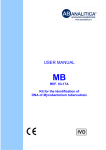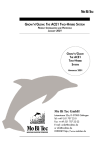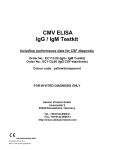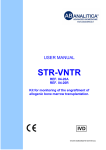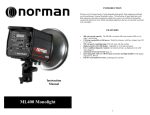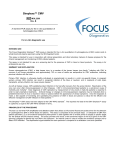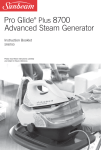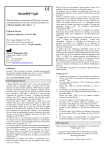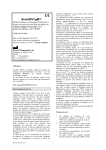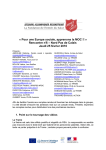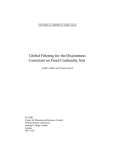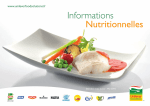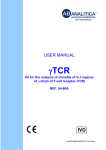Download AMPLIQUALITY
Transcript
USER MANUAL AMPLIQUALITY CMV ref. 03-22A ref. 03-22R Kit for the detection of Human Cytomegalovirus 0123 03-22A-50(8033622781578)-EN.doc 1. PRODUCT INFORMATION...................................................................... 3 2. KIT CONTENT.......................................................................................... 4 3. STORAGE AND STABILITY OF THE REAGENTS................................. 5 4. PRECAUTIONS FOR USE....................................................................... 6 5. SAFETY RULES ...................................................................................... 7 5.1. General safety rules ............................................................................ 7 5.2. Safety rules about the kit .................................................................... 7 6. MATERIALS REQUIRED, BUT NOT PROVIDED ................................... 9 6.1. Reagents............................................................................................... 9 6.2. Instruments .......................................................................................... 9 6.3. Materials ............................................................................................... 9 7. PREPARATION OF THE REAGENTS................................................... 10 8. INTRODUCTION .................................................................................... 11 9. TEST PRINCIPLE................................................................................... 13 10. PRODUCT DESCRIPTION ................................................................. 14 11. COLLECTION, MANIPULATION AND PRE-TREATMENT OF THE SAMPLES..................................................................................................... 15 11.1. Biological fluids .............................................................................. 15 11.2. Blood ............................................................................................... 16 12. 12.1. EXTRACTION PROTOCOL ................................................................ 17 DNA extraction................................................................................ 17 12.2. DNA amplification........................................................................... 17 12.2.1. BG DNA amplification 17 pag. 1 03-22A-50(8033622781578)-EN.doc 12.2.2. Direct amplification (1st amplification) of Cytomegalovirus DNA: 17 12.3. Visualization of the amplification products ................................. 18 12.3.1. Agarose gel electrophoresis 18 12.3.2. Sample Loading 19 12.4. INTERPRETATION OF THE RESULTS: BG DNA amplification and CMV first amplification ............................................................................... 20 12.5. 2nd Cytomegalovirus DNA amplification (nested PCR) ............... 21 12.6. RESULTS INTERPRETATION: second amplification of Cytomegalovirus DNA ................................................................................ 22 13. TROUBLESHOOTING ........................................................................ 23 14. DEVICE LIMITS................................................................................... 25 15. DEVICE PERFORMANCES ................................................................ 25 15.1. Specificity........................................................................................ 25 15.2. Sensitivity........................................................................................ 25 16. BIBLIOGRAPHIC REFERENCES....................................................... 26 pag. 2 03-22A-50(8033622781578)-EN.doc 1. PRODUCT INFORMATION This manual is related to the following products: CMV: Kit for the detection of Cytomegalovirus by DNA amplification in the UL122 region (IE2 exon 4). The kit contains the reagents for DNA amplification and visualization by agarose gel electrophoresis, the internal control of sample amplificability and positive control. Cod. 03-22A-25 03-22A-50 Prod CMV CMV Pkg 25 test 50 test CMV - amplification reagents Reagents for the detection of Cytomegalovirus by DNA amplification in the UL122 region (IE2 exon 4). The kit contains the reagents for DNA amplification, the internal control of sample amplificability and the positive control. Cod. 03-22R-25 03-22R-50 Prod CMV- amplification reagents CMV- amplification reagents pag. 3 03-22A-50(8033622781578)-EN.doc Pkg 25 test 50 test 2. KIT CONTENT NOTE: In the kits with different codes different components are included. (legenda: X = component included in the kit; 0 = component not included in the kit) BOX P cod. 03-22A cod. 03-22R STORE AT – 20°C DESCRIPTION LABEL COLOUR OF TUBE (T) OR LID 25 test 50 test 8 test X X monodose premixes for direct CMV amplification Red (T) 25 50 8 X X monodose premixes for nested CMV amplification Green (T) 25 50 8 X X monodose premixes for β-globin gene amplification Blue (T) 25 50 8 X X Thermostable Hot-start TAQ DNA polymerase Red 1 x 40μL 1 x 80μL 1 x 20μL AB SuperTaq 5 U/μL SMALL BAG cod. 03-22A cod. 03-22R STORE AT – 20°C X X DESCRIPTION Plasmid DNA containing part of Cytomegalovirus genome LABEL COLOUR OF TUBE (T) OR LID 25 test 50 test 8 test CMV positive control Blue 1 x 30 μL 1 x 50 μL 1 x 10 μL BOX F cod. 03-22A cod. 03-22R STORE AT +2°/ +8°C X 0 LABEL COLOUR OF TUBE (T) OR LID 25 test 50 test 8 test Loading Buffer for electrophoresis 6X Blue Blue 1X250μL 1X450μL 1X100μL Ethidium Bromide TOXIC R 23 68 S 36/37 45 Red 1X170μL 1X250μL 1X100μL Marker PM Yellow 1X200μL 1X400μL 1X70μL DESCRIPTION X 0 Ethidium Bromide solution (2,5 mg/mL) X 0 DNA Molecular Weight Marker pag. 4 03-22A-50(8033622781578)-EN.doc BOX A cod. 03-22A cod. 03-22R STORE AT +15°/ +25°C DESCRIPTION LABEL COLOUR OF TUBE (T) OR LID 25 test 50 test 8 test X 0 Agarose Molecular Biology grade AGAROSE 1X20g 1X40g 1X6g X 0 Electrophoresis buffer TRIS-Acetate-EDTA, pH 8,00 50X TAE 1X60mL 1X125mL 1X30mL 3. STORAGE AND STABILITY OF THE REAGENTS Each component of the kit should be stored according to the directions indicated on the label of the single boxes. In particular: Box P Small bag Box F Box A store at -20°C store at -20°C store at a +2 / +8°C store at +15 / +25°C When stored at the recommended temperature, all test reagents are stable until their expiration date. pag. 5 03-22A-50(8033622781578)-EN.doc 4. PRECAUTIONS FOR USE • The kit should be handled by investigator qualified through education and training in molecular biology techniques applied to diagnostics; • Before starting the kit procedure, read carefully and completely the instruction manual; • Keep the product away from sources of heat product out of heating sources; • Do not use any part of the kit if over the expiration date; • In case of any doubt about the storage conditions, box integrity or method application, contact AB ANALITICA technical support at: [email protected] . In the amplification of nucleic acids, the investigator has to take the following special precautions: • Use filter-tips; • Store the biological samples, the extracted DNA, positive control included in the kit and all the amplification products in different places from where amplification reagents are stored. • Organise the space in different pre- and post-PCR units; do not share consumables (pipets, tips, tubes, etc) between them. • Change the gloves frequently; • Wash the bench surfaces with 5% sodium hypochloride; • Thaw the PCR premixes at room temperature before use. Add the Taq DNA polymerase and purified DNA very quickly at room temperature or in an ice-bath. pag. 6 03-22A-50(8033622781578)-EN.doc 5. SAFETY RULES 5.1. General safety rules • Wear disposable gloves to handle the reagents and the clinical samples and wash the hands at the end of work. • Do not pipet with mouth. • Since no known diagnostic method can assure the absence of infective agents, it is a good rule to consider every clinical sample as potentially infectious and handle it as such. • All the devices that get directly in touch with clinical samples should be considered as contaminated and disposed as such. In case of accidental spilling of the samples, clean up with 10% Sodium Hypochloride. The materials used to clean up should be disposed in special containers for contaminated products. • Clinical samples, materials and contaminated products should be disposed after decontamination by: immersion in a solution of 5% Sodium Hypochloride (1 volume of 5% Sodium Hypochloride solution every 10 volumes of contaminated fluid) for 30 minutes OR autoclaving at 121°C at least for 2 hours (NOTE: do not autoclave solutions containing Sodium Hypochloride!!). 5.2. Safety rules about the kit The risks for the use of this kit are related to the single components: Dangerous components: ETHIDIUM BROMIDE (included in the 03-22A kit) 3,8-diamino-1-ethyl-6-phenylphenantridiumbromide <2% Description of risk: T (Toxic) pag. 7 03-22A-50(8033622781578)-EN.doc RISK SENTENCES AND S SENTENCES ETHIDIUM BROMIDE R 23 and R 68 S 36/37 45 Toxic for inhalation. Risk of irreversible effects. Wear laboratory coat and disposable gloves. In case of accident or discomfort, seek for medical assistance and show the package label. R and S sentences refer to the concentrated product, as provided in the kit. In particular, for Ethidium Bromide, until the dilution in the agarose gel. In manipulating concentrated Ethidium Bromide, use a chemical dispensing fume cabinet. Always wear disposable gloves and laboratory coat in manipulating the diluted Ethidium solution as well. The product can not be disposed with the common waste. It must not reach the drainer system. For the disposal, follow the local law. In case of accidental spilling of Ethidium Bromide, clean with Sodium hypochloride and water. Safety data sheet (MSDS) of the product is available upon request. . pag. 8 03-22A-50(8033622781578)-EN.doc 6. MATERIALS REQUIRED, BUT NOT PROVIDED 6.1. Reagents • Reagents for DNA extraction; • Sterile DNase and RNase free water; • Distilled water; • Reagents for DNA visualization by agarose gel electrophoresis (necessary for 03-22R kit). 6.2. Instruments • Laminar flow cabinet (use is recommended while adding TAQ polymerase to the amplification premix to avoid contamination; it would be recommended to use another laminar flow cabinet to add the extracted DNA); • Micropipettes (range: 0,2-2 µL; 0,5-10 µL; 2-20 µL); • Thermalcycler; • Microcentrifuge (max 12.000-14.000 rpm); • Balance; • Magnetic heating stirrer or microwave; • Chemical cabinet (use is recommended in handling Ethidium Bromide); • Horizontal electrophoresis chamber for agarose minigel; • Power supply (50-150 V); • UV Transilluminator; • Photo camera or image analyzer. 6.3. Materials • Disposable gloves; • Disposable sterile filter-tips (range: 0,2-2 µL; 0,5-10 µL; 2-20 µL;); • Graduate cilinders (1 L) for TAE dilution; • Pyrex bottle or Becker for agarose gel preparation; • Parafilm. pag. 9 03-22A-50(8033622781578)-EN.doc 7. PREPARATION OF THE REAGENTS Preparation of 1 L of 1X TAE buffer: Mix 20 mL of 50X TAE with 980 mL of distilled water. pag. 10 03-22A-50(8033622781578)-EN.doc 8. INTRODUCTION The understanding about biology and pathogenesis of Cytomegalovirus (CMV) infection have been tremendously improved first by the development of cellular culture techniques and recently by molecular biology. It has been registered that the spread of the infection among population has been constantly high (40%-100%), but recently the number and the variety of the symptomatically evident infections (cytomegalic desease) have shown a great increase, as consequence of the increased number of immunocompromised or immuno-immature subjects (immature newborn, transplants, malignant tumours, splenectomy, transfusions, HIV infections, old age) (Vancikova Z. and Dvorak P., 2001). In healthy subjects the CMV infection is usually asymptomatic. Cytomegalovirus is a virus belonging to the Herpesviridae family: it is an ubiquitous agent that infects several animal species, human included, and it is highly species-specific. CMV virus has a very slow replicative cycle and produces nuclear and cytoplasmic inclusion bodies. It has a double-stranded linear genome, that measures about 240 Kb; during the infection process, in the host a specific DNA polymerase of alfa-specific type is synthesized, associated to a highly immunogenic protein with 3’-5’ exonucleasic activity is associated to it. CMV genome can survive in the host cell in a latent stage (with the possibility of successive reactivations), otherwise it can induce a persistent infection or a lytic cycle; during the productive inflammation the sequential expression of the viral genome sequence is time-regulated by genes classified in three categories: immediate early (IE or alfa), early (E or beta) and late (L or gamma) (Mocarski ES, 1996). In CMV infected patients, the virus replicates in different organs as lungs, liver, kidney, gastrointestinal tract and it is excreted through saliva, breast milk, spermatic fluid, urine, cervical and vaginal secretions, tears, blood and faeces. The affected districts are different, depending on the cause of the immunodeficiency (tab.1). CMV has cytopathic effect: it causes tissue damages with the formation of cytomegalic cells containing intranuclear inclusions. pag. 11 03-22A-50(8033622781578)-EN.doc Tab 1. CMV disease in immunosuppressed patients. (Razonable and Emery, 2004) Symptom Fever or Hepatitis Gastrointestinal symptoms Retinitis Pneumonia Encephalopathy Deafness Polyradiculopathy Addison disease’s symptoms Transplant rejection Atherosclerosis Death Newborn + + SOT ++ + + + HSCT + ++ + ++ ++ ++ AIDS + + ++ + + + + + + + + SOT: Solid Organ Transplant; HSCT: Haematopoietic stem Cell Transplant; AIDS: Acquired Immunodeficiency Syndrome In the past, the standard methods to diagnose CMV included several techniques for virus isolation from cell cultures and for the search of pp65 antigen from peripheral blood leukocytes (Razonable et al., 2002a). Since the therapy is fundamental in the prevention of cytomegalic disease in particular subjects, the application of more sensitive and reproducible methods, such as molecular techniques, was required. pag. 12 03-22A-50(8033622781578)-EN.doc 9. TEST PRINCIPLE PCR method (Polymerase Chain Reaction) has been the first method of DNA amplification described in literature (Saiki RK et al., 1985). It can be defined as an in vitro amplification reaction of a specific part of DNA (target sequence) by a thermostable DNA polymerase. Three nucleic acid segments are involved in the reaction: double stranded DNA template to be amplified (target DNA) and two single-stranded oligonucleotides “primers” that are designed in order to anneal specifically to the template DNA. The DNA polymerase begins the synthesis process at the region marked by the primers and synthesizes new double stranded DNA molecules, identical to the original double stranded target DNA region, by facilitating the binding and joining of the complementary nucleotides that are free in solution (dNTPs). After several cycles, one can get millions of DNA molecules which correspond to the target sequence. The sensitivity of this test makes it particularly suitable for the application in laboratory diagnostics. Moreover, the amplification reaction can be executed from a wide range of biological samples and since it allows to amplify very small DNA fragments, the starting DNA can be also partially degraded. pag. 13 03-22A-50(8033622781578)-EN.doc 10. PRODUCT DESCRIPTION The method proposed in this kit consists of the amplification of the viral DNA in the UL122 region. The method allows also to evaluate the suitability of extracted DNA, by the amplification of β-globin (BG) gene (amplification control). A negative result in BG gene amplification indicates either the presence of inhibitors of the amplification reaction in the extracted DNA or that the DNA is highly degraded. This method helps the operator to recognize possible false negative results for Cytomegalovirus. The kit also provides with a positive control of amplification. When the amplification of the positive control is successful, it is guaranteed that the reaction is correct. This control is not dangerous for the operator because it is plasmid DNA containing only a part of Cytomegalovirus genome. The kit is in premix format: all the reagents for the amplification are pre-mixed and aliquoted in monodose test tubes (0,2 or 0,5 mL) to which Taq polymerase and the extracted DNA will be added. This premix format allows the reduction of the manipulation steps in preamplification, with considerable time saving for the operator; the repeated freezing/thawing of reagents (that could alter the product performances) is avoided and, above all, this format minimizes the risk of contamination, so the risk to get false positive results. Nevertheless, it’s always recommended to use all the proper amplification controls. pag. 14 03-22A-50(8033622781578)-EN.doc 11. COLLECTION, MANIPULATION AND PRETREATMENT OF THE SAMPLES CMV can be in free, episomal or integrated form and this is determinant in the choice of the protocol to use for isolation and subsequent virus identification. CMV DNA can be directly extracted from several biologic fluids like spermatic fluid, maternal milk, vaginal and cervical secretions, saliva, serum, etc.; If starting from urine or liquor (CSF) a preliminary centrifugation of the sample is required, to obtain a pellet enriched of cells. Sometimes also the supernatant is tested. If starting from peripheral blood to search CMV in leukocytes (PBL) or in mononuclear cells (PBMC), a further step for obtaining a lymphocyte pellet (by FICOLL Method or red blood cells lysis) is necessary. CMV DNA can be extracted also from whole blood. 11.1. Biological fluids In the case of cervix and vaginal swabs, sample collection is performed by the use of a little swab or a little sterile brush (cyto-brush). The collected cells are diluted in a suitable transport media (1X PBS, physiological solution or other medium). The sample can be stored at +2 / +8°C for max 48 h; after then, it is better to proceed with nucleic acid extraction. If it is not possible to extract the sample in a short time, the specimen must be stored at -20°C. When sample cellularity is too low, it could be necessary, before starting DNA extraction, to concentrate the sample by repeated centrifugation steps. For sample resuspension, sterile PBS can be used. It can be useful also to remove mucus and red cells, if present. Collect the seminal liquid in a sterile container and store it at +4°C for some hours (maximum overnight); alternatively, it can be frozen with addition of a suitable media for DNA extraction. Urine should be collected in a sterile container, stored at +2/+8°C for max 24 h and then processed. pag. 15 03-22A-50(8033622781578)-EN.doc The application of molecular technique allowed a better diagnosis and characterization of clinical Central Nervous System syndromes associated to CMV infection. In this case, the sample of choice is liquor (CSF). The liquor sample can be stored at room temperature or at +2/+8°C, if processed in a short time; alternatively it is suggested to freeze the sample. 11.2. Blood Since long time it was discussed about which was the blood compartment that was best indicated for CMV analysis. A recent prospective study (Razonable et al., 2002b) compared 4 blood compartments (whole blood, plasma, PBL, PBMC) of 17 SOT (Solid Organ Transplant) and HSCT (Haematopoietic Stem Cell Transplant) patients and demonstrated that even if all this sample types are suitable for CMV search both for prognosis and therapy monitoring aims, whole blood seems to be more sensitive when CMV is present in low number of copies. Later, other publications supported these data (Weinbeerg et al., 2002, Cortez et al., 2003, Mengelle et al., 2003). The IHMF (International Herpes Management Forum) guidelines suggest, where possibile, the use of whole blood for CMV search in transplanted patients (Razonable and Emery, 2004). Sample collection should follow all the usual sterility precautions, as routine; it should be transported in sterile boxes, without transport medium. Blood should be treated with EDTA. Other anticoagulating agents, as heparin, are strong inhibitors of TAQ polymerase and so they could alter the efficiency of the amplification reaction. Fresh blood can be stored at +2 / +8°C (processed within 4 hours from the collection); if DNA is not shortly extracted, the sample must be frozen at 20°C. If the investigator prefers to start the analysis from a leukocyte pellet, the Ficoll-Hypaque method or the erythrocyte lysis protocol for lymphocytes isolation can be used. Alternatively, a buffy coat can be prepared by whole blood centrifugation at 3300 x g for 10 min at room temperature. After centrifugation, three different fractions can be observed: the upper clear phase is the plasma, the intermediate phase is the buffy coat , that contains concentrated leukocytes, and the lowest contains erythrocytes. pag. 16 03-22A-50(8033622781578)-EN.doc 12. EXTRACTION PROTOCOL 12.1. DNA extraction Any extraction method can be used, provided that it extracts pure and integral DNA. It is necessary to remember that the volumes of the extracted DNA, indicated in paragraph 12.2 for BG and CMV amplification, are referred to the extracts obtained with AB ANALTICA methods. Using an alternative extraction method, if the volume of the DNA solution to amplify is less than 10 μL, it will be necessary to adjust the volume of the amplification mix by adding water. 12.2. DNA amplification 12.2.1. BG DNA amplification For each sample add to each premixed tube (blue tube): 0,2 µL AB Super Taq 10 µL extracted DNA 12.2.2. Direct amplification (1st amplification) of CMV DNA For each sample add to each premixed red tube: 0,2 µL AB Super Taq 10 µL extracted DNA It is important to include in each experiment a negative control (add to the mix distilled water instead of DNA) and a positive control (10 μL of the positive control included in the kit). pag. 17 03-22A-50(8033622781578)-EN.doc Centrifuge briefly, put the tubes (BG and CMV) into the thermalcycler programmed as below: 1 cycle 40 cycles 1 cycle 95°C 5 min 95°C 60 sec 56°C 60 sec 72°C 60 sec 72°C 5 min Amplification products lenght: CMV BG 12.3. 472 bp. 268 bp. Visualization of the amplification products 12.3.1. Agarose gel electrophoresis Prepare a 3% agarose gel: Weight 1.5 g of Agarose and pour it into 50 mL of 1x TAE. Leave the solution on a magnetic stirring heater or in a microwave, until the solution becomes clear. Allow the gel to cool to “hand warm” and then add 10 µL of Ethidium Bromide solution (2.5 mg/ml). NOTICE: Ethidium Bromide is a strong mutagenic agent; always wear gloves and preferably work under a chemical safety cabinet during the handling of this reagent or gels containing it. Place the gel into the appropriate gel casting tray, with the comb placed in and allow the gel to cool at room temperature or in a fridge until the gel becomes solid. When the gel is solidified, remove carefully the comb (pay attention not to damage the gel wells) transfer the tray into the electrophoresis chamber and pour the appropriate amount of 1x TAE buffer so that it covers completely the gel (about 1-2 mm over the gel surface). pag. 18 03-22A-50(8033622781578)-EN.doc 12.3.2. Sample Loading Mix into a tube or directly on a parafilm layer: 2 μL 10 μL of 6X Blue* of amplification product or Molecular weight Marker (PM*marker) Load the mixture in the gel wells; switch on the power supply and set the voltage between 80-100 V. Run the gel for about 40 min, then place the gel on an UV transilluminator and analyze the results by comparing the size of the amplification products with the reference Molecular Weight Marker. *: 6X Blue and PM Marker are included in 03-22A kit; for the use of another loading buffer or of another Molecular Weight Marker, follow the indications specified by the supplier. DNA Molecular Weight Marker (PM Marker, included in 03-22A kit) fragment sizes: 501-489, 404, 353, 242, 190, 147, 110, 89, 67, 34, 26 bp. NOTE: In a 3% agarose gel the 501-489 bp bands are usually not clearly resolved and appear as an unique band; the 26 and 34 bp bands are sometimes too small to be visible in a 3% agarose gel (because of their low molecular weight). NOTICE: UV rays are dangerous for skin and, above all, eyes: always wear gloves and safety glass or make use of the protection screen of the UV transilluminator. pag. 19 03-22A-50(8033622781578)-EN.doc 12.4. INTERPRETATION OF THE RESULTS: BG DNA amplification and CMV first amplification The controls should show the following results: CONTROL RESULT Positive control POSITIVE Negative NEGATIVE control INTERPRETATION The PCR amplification is correct Absence of contaminations Then, for the interpretation of the band pattern, follow the table below: DNA BAND RESULT INTERPRETATION BG gene band absent BG gene band CMV band present absent BG gene band CMV band present present Sample not suitable for amplification (repeat the DNA extraction) Amplificable sample Proceed with the second amplification to value the true sample negativity Amplificable sample positive sample for CMV. pag. 20 03-22A-50(8033622781578)-EN.doc 12.5. CMV nested amplification (2nd DNA amplification) Add to each premixed green tube: 0,2 µL AB Super Taq 1 µL First amplification product It is important to include in this step the negative and the positive controls used in the CMV direct amplification. When considered useful, it is possible to include also a negative control for the nested amplification, by adding to the nested mix 1 µL of sterile water, instead of the direct amplification product. Centrifuge briefly, then put the tubes into the thermalcycler programmed as below: 1 cycle 35 cycles 1 cycle 95°C 5 min 95°C 30 sec 62°C 30 sec 72°C 30 sec 72°C 5 min Nested amplification: CMV fragment lenght: 183 bp. At the end of the amplification run, visualize the nested amplification products by 3% agarose gel electrophoresis. Weight 1.5 g of Agarose and pour it into 50 mL of 1x TAE. Follow the instructions indicated at paragraph 12.3. pag. 21 03-22A-50(8033622781578)-EN.doc 12.6. INTERPRETATION OF THE RESULTS: second amplification of Cytomegalovirus DNA The controls should show the following results: CONTROL RESULT Positive control POSITIVE Negative Control NEGATIVE Negative control Nested amplification NEGATIVE INTERPRETATION The first and the second amplification are correct Absence of contaminations in the first amplification Absence of contaminations in the second amplification Then, for the interpretation of the band pattern, follow the table below: DNA BAND RESULT CMV band in the first and absent second amplification CMV band in the second present amplification 1 2 3 INTERPRETATION Negative sample for Cytomegalovirus Positive sample for Cytomegalovirus 4 Fig. 1: 3% agarose gel electrophoresis of the amplification products. 1 DNA Molecular Weight Marker (MW) 2 Positive control for CMV DNA 3 CMV positive sample 4 Negative control pag. 22 03-22A-50(8033622781578)-EN.doc 13. TROUBLESHOOTING 1. Neither amplification products, nor positive control DNA band • TAQ polymerase was not correctly added to the premix – Use pipets and tips of suitable volume range (pipet range 0,2 - 2 μL); – Check visually that TAQ polymerase diffuses in the premix: this is easy because the enzyme is dissolved in glycerol that has a higher density; – Alternatively, check visually the drop of TAQ polymerase put on the tube wall, then centrifuge briefly. ________________________________________________________________________________ • The thermalcycler was not correctly programmed – Check the conformity of the thermalcycler program and the temperature profile in the instruction manual; then repeat the amplification with the correct program. ________________________________________________________________________________ • The kit doesn’t work properly – Store the premix, TAQ polymerase and positive control at -20°C; – Avoid repeated freezing/thawing of the premix and the reagents. ________________________________________________________________________________ 2. No amplification bands nor for BG neither Cytomegalovirus in the tested sample, but a good band for positive controls • Problems during the extraction step – Be sure that the extraction kit is adequate and that you followed correctly all the instructions; – Consult the troubleshooting section of the extraction kit user manual; – Repeat the DNA extraction starting from a new sample. ________________________________________________________________________________ • The amplification was inhibited – Dilute the starting sample with distilled water and TE; – Repeat the DNA extraction from a smaller amount of clinical sample; pag. 23 03-22A-50(8033622781578)-EN.doc – Use an adequate extraction system. ________________________________________________________________________________ 3. Presence of aspecific products or extrabands after the visualization of the amplified products in agarose gel • The thermalcycler makes temperature changes too slowly – Do a thermalcycler revision. ________________________________________________________________________________ • The preparation of the amplification reaction has been executed in a long time at room temperature – Accelerate the work time at room temperature; – Work on ice. _______________________________________________________________________________ • The starting sample contained degraded DNA – Repeat the extraction step using another clinical specimen; – Be sure that the sample had been collected and stored in appropriate way. For any further problem contact AB ANALITICA technical support (e-mail: [email protected]. pag. 24 03-22A-50(8033622781578)-EN.doc 14. DEVICE LIMITS The kit can have reduced performances if: • the clinical sample is not suitable for this analysis (not correct transport media or not correct sample storage); • the DNA is not amplifiable because of the presence of inhibitors of the amplification reaction or due to an inadequate extraction system; • the kit has not been stored at the suggested temperature. 15. DEVICE PERFORMANCES 15.1. Specificity Primer sequence alignment in the most important databanks shows the absence of unspecific alignment, and it has guaranteed the amplification of Cytomegalovirus. Cross reactions with genomic DNA or other pathogenic microorganism nucleic acid have not been revealed. 15.2. Sensitivity With reference to other nested PCR diagnostic methods, it was assumed that the sensitivity of the kit is less than 50 DNA copies. pag. 25 03-22A-50(8033622781578)-EN.doc 16. BIBLIOGRAPHIC REFERENCES Cortez KJ, Fisher SH, Fahle GA et al. J Infect Dis 188, 967-972, 2003. Mengelle C, Sandres-Saune K, Pasquier C et al. J Clin Microbiol 41, 38403845, 2003. Mocarski ES. Virology (Fields BN, Knipe DM, Howley PM, eds). Philadelphia: Lippincott-Raven, 1996, 2447-2492. Razonable RR, Brown RA, Wilson J et al. Transplantation 73, 968-973, 2002b. Razonable RR and Emery VC. Herpes 11(3), 77-86, 2004. Razonable RR, Paya CV, Smith TF. J Clin Microbiol 40, 746-752, 2002a. Saiki RK, Scharf S, Faloona F et al. Science 230, 1350-1354, 1985. Vancikova Z and Dvorak P. Curr Drug Targets Immune Endocr Metabol Disord 1, 179-187, 2001. Weinberg A, Schissel D, Giller R. J Clin Microbiol 40, 4203-4206, 2002. pag. 26 03-22A-50(8033622781578)-EN.doc pag. 27 03-22A-50(8033622781578)-EN.doc pag. 28 03-22A-50(8033622781578)-EN.doc pag. 29 03-22A-50(8033622781578)-EN.doc AB ANALITICA srl - Via Svizzera 16 - 35127 PADOVA, (ITALY) Tel +39 049 761698 - Fax +39 049 8709510 e-mail: [email protected]

































